If you want an idea of how key to Baltimore the Francis Scott Key Bridge is, here are some photos to remind you:
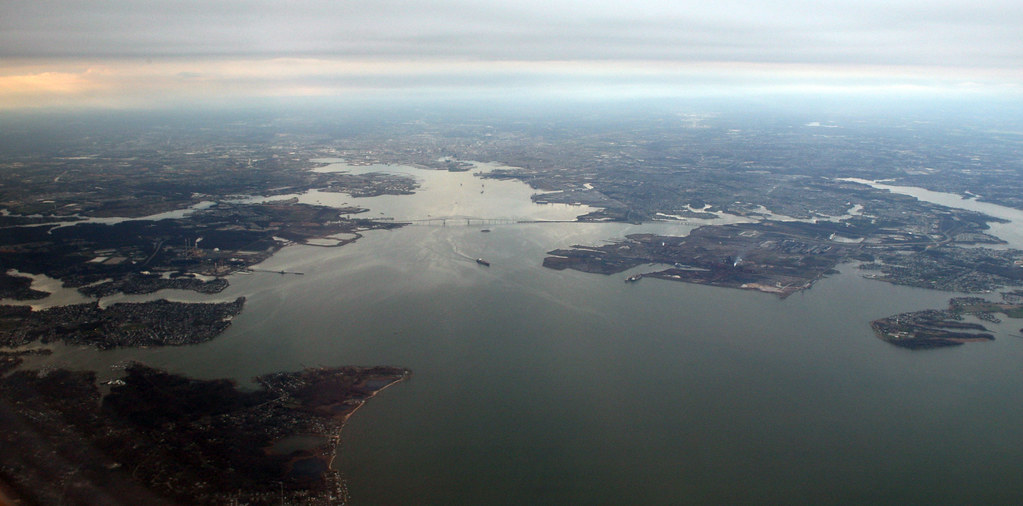
Baltimore Harbor. Note the Francis Scott Key Bridge, above the middle.
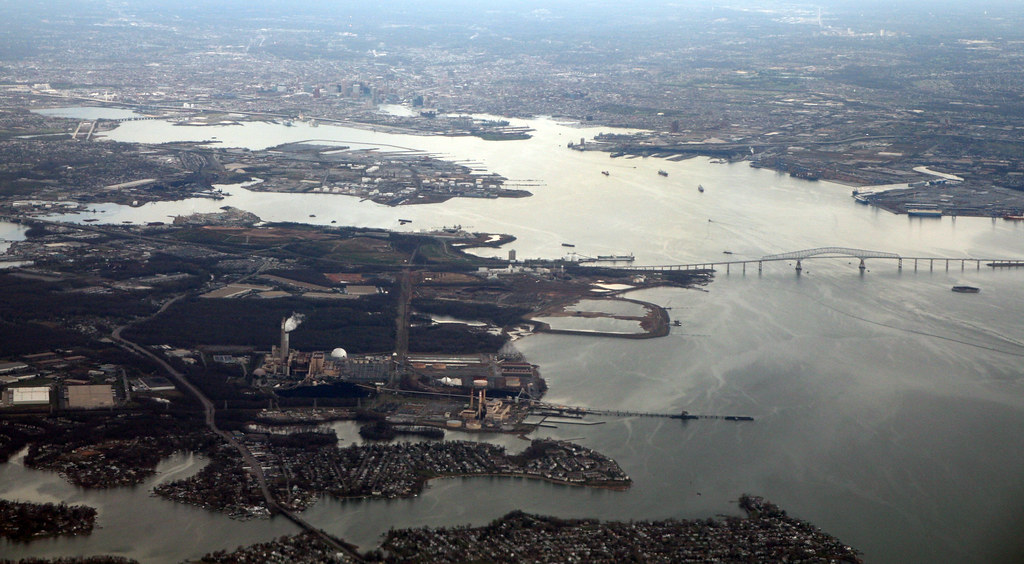
On the right is the Francis Scott Key Bridge, also known in its time as the Car Strangled Spanner. It was dropped by the MV Dali container ship. Note that these ships all load and unload on the far side of the bridge at many docking sites. All need to thread the eye of the bridge’s needle.
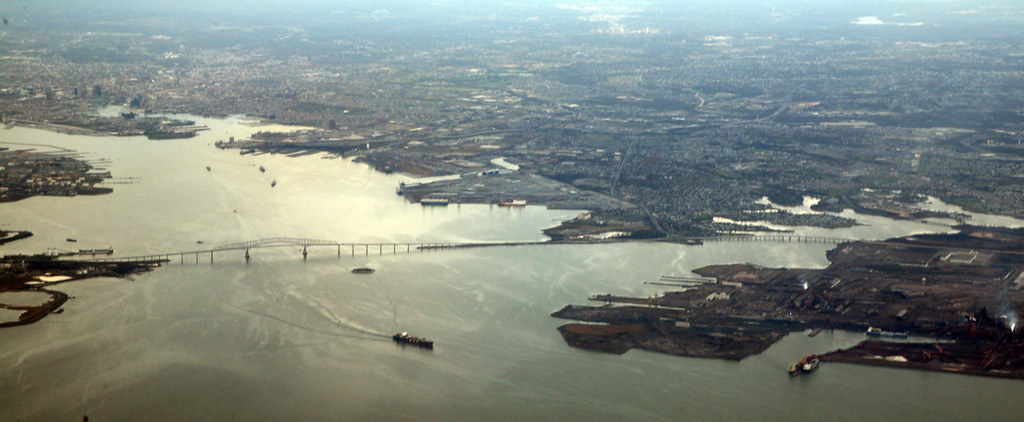
This view shows the whole span of the bridge, from the north side to the south, across the mouth of the harbor.
Those three are among six I’ve posted on Flickr for the sole purpose of making them useful. Such as now, twelve years after I shot them. Because yesterday an errant cargo ship, the MV Dali, brought the bridge down by taking out the southwest support column (left side in this view) for the central span, killing at least six people and leaving the “Car Strangled Spanner” out of commission for the next few years.
Like all my other public photos, these are Creative Commons licensed to require only attribution. I see this as the infrastructure of public photography supporting the infrastructures of journalism and archivy.*
Photographically, they aren’t great. But they are free, so if you’re writing about the bridge and want an easy photo to use, have at ’em.
*Meaning (if you skip that link) “the discipline of archives.” For the practice of creating and maintaining archives, I prefer archivery, and would have used it here if a search for that word hadn’t suggested archivy instead.
Tags: Building · Emergency · Geography · Industry · Media · Photography · Roads/Bridges · Travel · Water

“American vs. Canadian Radio” — drawn by bing.com/images/create
A couple of years ago I was asked on Quora, “How do American radio stations compare to Canadian stations?” This was my answer.
Mostly the differences are regulatory. But some are also geographic. Examples:
- The Canadian government has a national network, the CBC, much as does the U.K. with the BBC. And, like the BBC, it’s very reputable. Both are “royal” entities, for which there is no U.S. equivalent. (And no, NPR doesn’t qualify, since it’s independent of the federal government and almost entirely—last report, 98+%—paid for by member stations, sponsorships and underwriting.)
- Programming is more highly regulated, especially around music, in Canada. For example, the Canadian Radio-Televsion and Communmicatons Commission (CRTC) has Canadian content requirements for music on Canadian radio, which requires that commercial, community, campus and native radio stations “must ensure that at least 35% of the Popular Music they broadcast each week is Canadian content.” The percentage for CBC stations is 50%.
- The CRTC is committed to sunsetting AM broadcasting, while the FCC is not. While there are still some CBC stations still on the AM band, many signals have either gone dark or have been sold off. Here is a list of the remaining CBC AM signals.
Despite Canada’s slow rollback of AM broadcasting, its prairie features an AM station with the largest daytime* coverage in the world: CBK/540 in Watrous, Saskatchewan. While there are lots of 50,000-watt stations in the world (and that’s the max allowed in the U.S. and Canada)—and a handful cranking out up to two million watts—CBK’s 50,000-watt transmitter sits on some of the most conductive dirt in the world, giving the station coverage that reaches from the Rockies in Alberta to the west, the shores of Hudson Bay to the east; and north across the borders of the Northwest Territories and Nunavut, and well into Montana, North Dakota, and Minnesota to the south:
One of those two million-watt giants is Transmitter Solt, for Kossuth Rádió, Hungary’s national radio station. While its signal is immense electronically, its daytime* coverage, while very large, is limited by relatively nonconductive ground. Still, in a way, Transmitter Solt is also Canadian, since the transmitter itself is made by Nautel, of Nova Scotia, which in recent years has become what some regard as the preeminent maker of broadcast transmitters.
______________________
*Note that coverage by day and night is vastly different for AM (aka MW) radio. That’s because in daytime the lowest (D) layer of the ionosphere absorbs signals in that band, and at night the same signals bounce off the next layer up (E) for distances typically of several hundred miles. Or, in cases like Transmitter Solt, thousands of miles. As a somewhat separate matter, shortwave signals bounce off the higher F1 and F2 layers. Check that last link for particulars.
Tags: Broadcasting · Geography · Radio

Joshua trees shot in pano mode by a phone in a moving car.
I’m making lemonade here. The lemon is erroneously putting an album of photos shot at Joshua Tree National Park into my Flickr site devoted to infrastructure rather than the one for everything else. The lemonade is giving this blog some juice in the form of a useful topic: absence of infrastructure. There is a lot of that in the world, and this park is an okay example.
I say okay because it’s not Antarctica, the middle of the ocean, or the Taklamakan. There is a paved road, on which tantalized visitors can gaze through car windows before they hike off on foot to look at wildlife, climb rocks, and enjoy other adventures. There is also some cell coverage, even though the park says there is none. We could get online most of the way to the Wall Street Stamp Mill ruins. Two days earlier we took a hike to Barker Dam, which also featured a bit of cell coverage.
Just off the trail nearby are the remains of a windpump style windmill, that supplied water for the mill and the ranches nearby. Not sure what anyone ranched there, but the windpump made a degree of civilization possible. And I suppose that’s what infrastructure is: a minimum requirement for the kind of life we call civilized.
Thoughts welcome.
Tags: Building · Discovery · Geography · History · Mining · Photography · Rural · Travel · Water
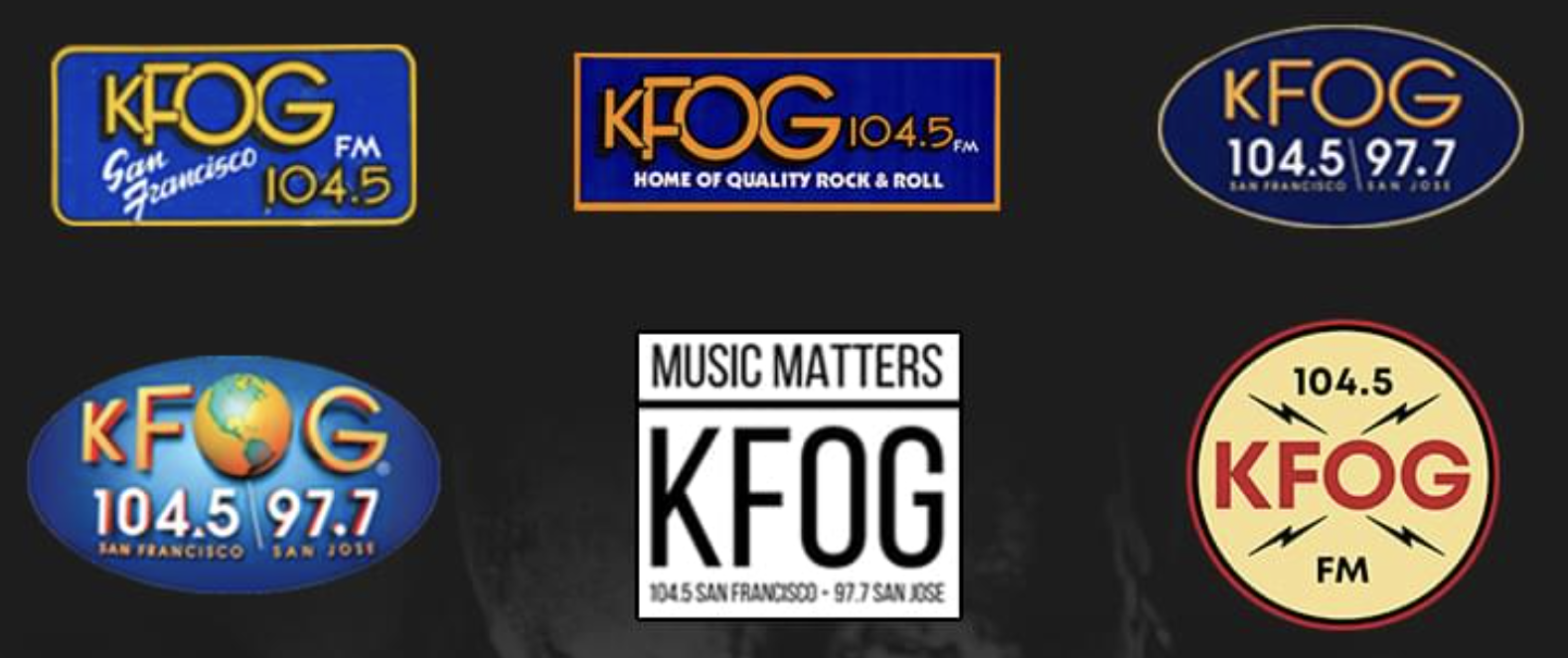
When I moved to Palo Alto from North Carolina in 1985, the preëminent rock station for the Bay Area was KFOG, on 104.5 FM. The morning jock was M. Dung (the on-air handle of Michael Slavko), who did more than anyone else to make me feel comfortable and welcome in a completely new environment. Like the rest of the station, M (what he usually called himself) was “always on, but a little off.”
My fave rock station in North Carolina had been WRDU/106.1, to which many friends who had worked at WQDR/94.7 had just migrated after that much-loved station flipped to country music. (A genre I also like, but we’re talking about friends here.)
From 1982 to 2017, KFOG was a great friend to fans of rock and related genres. You can see how much it was loved just by searching for it. The top results are tribute sites KFOG.com and KFOGisForever. Below those are a list of heartfelt lamentations.
I’ll carry this forward with my answer to a Quora question: Will 104.5 FM in San Francisco ever flip back to any music format?
In American radio, very few station formats are permanent. Two of the most durable are all-news and all-sports. For decades, the biggest all-news and all-sports stations in major markets were only on AM signals. Nearly all of those stations in recent years have added FM signals, displacing whatever was on the FM channel they moved to. All-news WINS/1010 in New York, WBBM/780 in Chicago, and KNX/1070 in Los Angeles moved to 92.3, 105.9, and 97.1 respectively, replacing the music stations on those channels. All-sports WEEI/850 in Boston and WFAN/660 in New York did the same when they moved to 93.7 and 101.9 in those cities. And KNBR/680 did the same in San Francisco when it added the signal at 104.5, long the home of KFOG.
Never mind that KNBR’s day signal covers a third of California and its night signal covers the whole Western U.S., while KFOG’s old signal barely covers the Bay Area. AM is a dead band walking. FM is where the listening is, and the signal at 104.5 is at least competitive. By now there are very few incumbent ratings leaders on AM that have not added an FM signal. KFI/640 in Los Angeles, WLW/700 in Cincinnati, KOA/850 in Denver, and WSCR/670 in Chicago are four that come to mind. There are a handful of others. Even with those, I’m sure it’s a matter of time before their owners find an FM signal to add.
In the longer term, FM is doomed as well. The Internet is slowly eating away at every incumbent communications medium: print, radio, TV, all of it. Your best radio is now the phone in your pocket or purse. All stations of any importance are there as well as on old-fashioned broadcast bands. If you want to hear KFOG again, there are a number of websites streaming the old programs. Nearly every piece of recorded music ever played on KFOG is also on music services from Apple, Amazon, Spotify, and other sources.
Here is another reason why KFOG is unlikely to return to the airwaves: rock music is still with us, but its era is over. We could argue that, but look up Rock Era and see what comes up. KFOG played a lot of genres other than pure rock (one of the things that made the station distinctive), but it was still a rock station.
Music genres today are largely created and maintained online, rather than on the air.
But hey, maybe the old KFOG will return someday.
But, if it does, it will need to pry the callsign from its current holder: KFOG/1250 in Little Rock, Arkansas. Might be a long shot, but money talks. If there is an economic case, it’s one worth making. And, for what it’s worth, the station mostly identifies as “Power 92” (named for its FM signal), and I read in June that the AM side was off the air.
In respect to infrastructure (the theme of this blog), my point is this: As we move into the Digital Age, the Internet and digital tech will finish absorbing and obsolescing every old analog communication system.
Radio’s age lasted roughly from the early twenties of the twentieth century to the early twenties of the twenty-first. Some of what it was will live on through streams and podcasts online. But it’s a matter of time before radios will only play hiss.
Tags: Broadcasting · Future · History · Industry · Over-the-Air (OTA) · Radio
November 9th, 2023 · 2 Comments
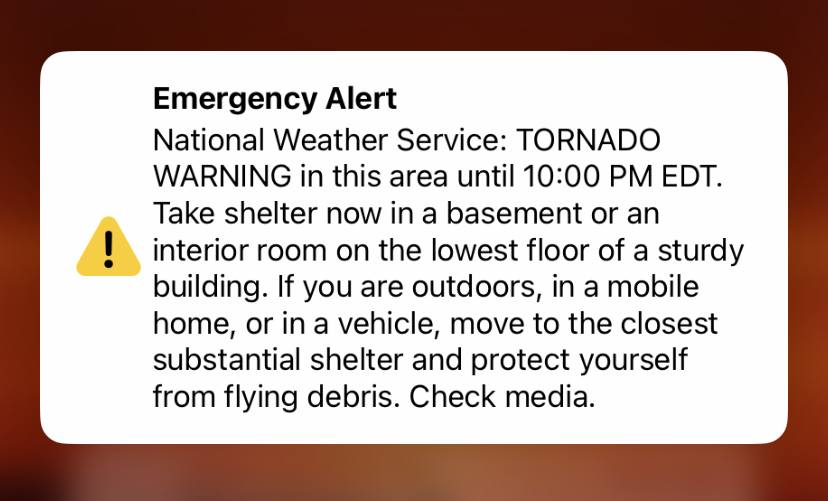
A few months ago, here in Bloomington, Indiana, everyone’s cell phone blasted an emergency warning sound, along with the alert above: a tornado waring. At the same time, civil emergency sirens wailed all over town.
A TORNADO WARNING means a tornado has been spotted or close enough. (A WATCH means there is a risk of a tornado.) Note the last two words: Check media.
That we did, here in the basement where I’m sitting right now. (It’s my office.) First I went to our only local AM station, WGCL/1370 (also 89.7 on FM). On the air was an interview with a guy talking about his tattoos. Then I checked all the local and regional radio stations listed here (on the LocalWiki where I dutifully put them):
Nothing. On any of them. Not even on WFIU, which is the substantial public station at Indiana University.
While I fiddled around with a portable radio, my wife wisely asked, “Have you checked Twitter?” I hadn’t, so I opened a browser on my computer, searched for #Bloomington and #Tornado, and got all the information we needed: everyone was hunkering down, and nobody had seen a tornado. So, we all lucked out.
But the experience was relevant to the regulatory alarms that were being raised, about car makers’ plans to drop AM radio from their cars’ dashboard infotainment systems. For example, Massachusetts Senator Ed Markey’s bill S. 1669: AM Radio for Every Vehicle Act of 2023 seeks required inclusion of AM radios in cars, so IPAWS, the Integrated Public Alert And Warning System “described in section 526 of the Homeland Security Act of 2002 (6 U.S.C. 321o)” (says the bill) would blast through AM radios, and hopefully save some listeners’ asses.
In a press release, the good Senator said this: “Unlike FM radio, AM radio operates at lower frequencies and longer wavelengths, enabling it to pass through solid objects and travel further than other radio waves.”
Not exactly. AM and FM work differently, but both have limited range, and every station has its own coverage pattern. And none of those equal cellular Internet and satellite radio in overall coverage, though both of those have limitations as well.
[As an aside, not long after I wrote this post, I visited two stations in one studio in Palm Springs, California, and published a photo album of the visit here. Best I can tell, both stations live off rent to cell companies for the tower behind their studios. And they don’t even own the tower anymore. A company that specializes in cell towers and rental owns it, and pays the station owner for the right to occupy the land. From what I saw, neither station was ready to deal with an emergency. Sure, maybe somebody could be called in, but on-site staffing was the exception, not the rule. Oh, and there was a third station once transmitting from the site, but that one was kindly donated to a local college whose staff and students weren’t interested in it, and turned in the license.]
If we were to zero-base radio today, we probably wouldn’t have stations at all. We’d have streams and podcasts, over the Internet, coming from anybody who wants to put out whatever they please. It would all be delivered by fiber, copper wiring, and cellular wireless, perhaps with satellite broadcasting thrown in.
Of course, we have that already.
By the way, Markey’s ploy worked, to some degree. For example, Ford reversed its plans to drop AM radio from its new cars. But AM towers everywhere are being logged off land sold to make room for housing developments and shipping centers. Examples: WMAL in Washington, WFNI in Indianapolis, and WFME in New York—to name a few among many.
Almost all the rest persist on shoestring budgets. You hear programming (now re-dubbed “content”) on their airwaves, but in most stations you will find no human beings sitting in a studio and working a control board with a microphone in their face. Those people got laid off long ago. Nearly all content is piped in from elsewhere. Voices included.
AM also sounds like shit. It doesn’t have to, but it does. For that problem you can mostly blame the radio makers, especially for cars. Switch from FM to AM, and it sounds like somebody just put a pillow over the speakers.
The simple fact is that AM radio is moving toward obsolescence while its popularity drops toward zero. (Ratings on the whole are bad and getting worse.)
Of course, emergency notifications are important. The question of how best to blast out those notifications and then get good news coverage during and after an emergency can be answered in lots of ways. But keeping AM stations running may not be the best of those options.
Tags: Broadcasting · Emergency · Radio
November 6th, 2023 · 1 Comment
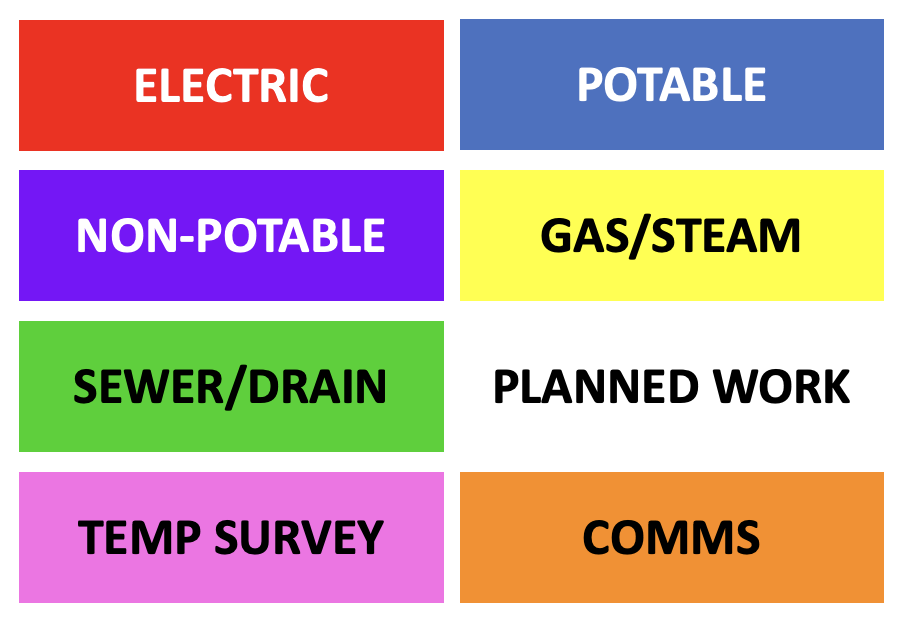
I wrote the following post in 2009. It holds up.
Toward Celebrating 8-11 Day
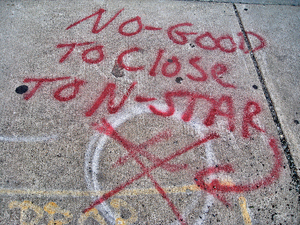
Mark Finnern has a great idea: Wikipedia papers. Specifically,
Every student that takes a class has to create or improve a Wikipedia page to the topic of the class. It shouldn’t be the only deliverable, but an important one.
The Wikimedia organization could help the professors with tools, that highlight the changes that a certain user has done on a page. You only pass, when the professor is satisfied with the scientific validity of the page. One could even mark the pages that went through this vetting process differently.
Instead of creating papers that end up in a drawer, you would create pages that you even feel ownership of and would make sure that they stay current and don’t get vandalized. You could even link to them on you LinkedIn profile.
It would make an enormous difference to the quality of Wikipedia year over year. One can think of wiki-how and other pages that could be improved using the same model.
There are other reasons. For example, Wikipedia has holes. Not all of these line up with classes being taught, but some might. Let’s take one example…

Wikipedia has an entry for 5-1-1, the phone number one calls in some U.S. states for road conditions. It also has an entry for 9-1-1, the number one calls in North America for emergency services. And, while it has an entry for 8-1-1, the “call before you dig” number in the U.S., it’s kinda stale. One paragraph:
All 811 services in the U.S. will end up using 611 by early 2007, as the United States Federal Communications Commission (FCC) in March 2005 made 811 the universal number for the 71 regional services that coordinate location services for underground public utilities in the U.S.[1][dated info] Currently, each of these “call before you dig” services, has its own 800 number, and the FCC and others want to make it as easy as possible for everyone planning an excavation to call first. This safety measure not only prevents damage that interrupts telecommunications, but also the cutting of electricity, water mains, and natural gas pipes. Establishment of an abbreviated dialing number for this purpose was required by the Pipeline Safety Improvement Act of 2002.
That last link takes you to one of those “Wikipedia does not have an article with this exact name” places. The “call before you dig” link redirects to Utility location. There you’ll find this paragraph:
One-call, Miss Utility, or Underground Service Alert are services that allow construction workers to contact utility companies, who will then denote where underground utilities are located via color-coding those locations. As required by law and assigned by the FCC, the 8-1-1 telephone number will soon be used for this purpose across the United States.
Well, it’s already being used. And it’s way freaking complicated, because there’s this very uneven overlap of entities — federal government, state goverenments, regional associations, and commercial entities, to name a few — that all have something to say.
For example, the U.S. Department of Transportation Pipeline and Hazardous Materials Safety Administration, or PHMSA. Right on their front page, they tell you April is Safe Digging Month. Good to know. April of what year? Next to a blurred emblem with an 811 over a shovel (a poor version the above, which comes from the Utility Notification Center of Colorado) and a horribly blurred graphic proclaiming WE SUPPORT SAFE DIGGING MONTH, a Call Before You Dig link leads to a page that explains,
Guidance for implementing safe and effective damage prevention for underground utilities was established by the Common Ground Alliance (CGA), a national organization representing all underground utility stakeholders. Calling before you dig is the first rule to remember when conducting underground related activities, no matter what the job is. The law requires you to phone the “One-Call” center at 8-1-1 at least two days prior to conducting any form of digging activity.
No link to the Common Ground Alliance. That org (a domain squatter has its .org URL, so it’s a .com) explains that it’s “a member-driven association dedicated to ensuring public safety, environmental protection, and the integrity of services by promoting effective damage prevention practices.” Its news page mentions that, among other things, August 11 is “8-11 Day”. It has a press release template in Word format. It also has news that “MGH Hired as CGA 811 Awareness Contractor” in .pdf. Within that one finds MGH’s website URL, where one finds that the agency is @mghus, which may be the hippest thing in this whole mess.
Digging further, one finds that there is a call811.com, which appears to be another face of the Common Ground Alliance. (If you’re interested, here are its “sponsors and ambassadors”.)
Also involved is the American Public Works Association. Apparently, the APWA is the outfit behind what LAonecall (one of the zillion of these with similar names) calls “the ULCC Uniform Color Code using the ANSI standard Z53.1 Safety Colors”. APWA must have published it at one point, but you won’t find it on its website. Hey, Google doesn’t. Though it does find lots of other sites that have it. Most are local or regional governmental entities. Or utilities like, say, Panhandle Energy. Here’s the graphic:

Here in New England (all of it other than Connecticut, anyway), the public face of this is Dig Safe System, Inc., which appears to be a nonprofit association, but there’s nothing on the site that says wtf it is — though it is informative in other respects. It does say, on its index page,
What is Dig Safe ®?
State laws require anyone who digs to notify utility companies before starting, and for good reason. Digging can be dangerous and costly without knowing where underground facilities are located.
Dig Safe ystem, Inc. is a communication network, assisting excavators, contractors and property owners in complying with state law by notifying the appropriate utilities before digging. Dig Safe®, a free service, notifies member companies of proposed excavation projects. In turn, these member utilities respond to the work area and identify the location of underground facilities. Callers are given a permit number as confirmation.
Member utilities, or contracted private locators, use paint, stakes or flags to identify the location of buried facilities. Color coding is used to identify the type of underground facilities… (and the same color coding as above)
I found out all of this — and much more — while I was researching for my column in the November issue of Linux Journal, which has Infrastructure the issue’s theme. I’m leveraging my leftovers here, closing one tab after another in my browser.
I’m also interested in approximately everything, one of which is the official-looking public graffiti on the ground all over the place. These are known locally as “dig safe markings”. At least that piece of the scattered one-call/call-before-you-dig/8-1-1 branding effort has taken root, at least here.
Anyway, I’d love to see a Wikipedia entry or two that pulls all this together. Maybe I should write it, but I’m busy. Hey, I’ve done this much already. Some actual experts ought to pick up the ball and post with it.
Which brings us back to Mark’s suggestion in the first place. Have a class do it.
Hey, @mghus, since you’re in Baltimore, how about suggesting a Wikipedia page project to The Civil & Environmental Engineering Department at UMBC?
Maybe for 8-11 Day?
[Update on 6 November 2023] Still no 8-11 Day, but the Wikipedia’s Utility Location article is pretty good now, covering various approaches around the world.
Tags: History · Standards · Underground

Mountains are temporary. All are in the queue for demolition, eventually. So is the whole planet. I explain that in The Universe is a Startup.
Blogs are more like beach sand. Or a whiteboard. So is the whole Web. In the old days we thought it was a library. Now we know it’s not. (Though the Internet Archive truly is, and that’s why we love it.)
On Saturday this blog and the one behind that first link—my personal one, which I’ve had at blogs.harvard.edu since 2007, will be gone from that domain. So will ProjectVRM, which I started at the Berkman Klein Center in 2006, and remains very active.
The challenge now is to migrate them to new domains.
Those qualify as infrastructure too. While they last.
Tags: Geography · History · Industry
September 24th, 2022 · No Comments

MEGO in journalism stands for My Eyes (or Ears) Glaze Over. According to William Safire , a MEGO os “a subject of great importance which resists reader interest.”
Infrastructure is a one-word MEGO.
So I haven’t written much about infrastructure, including here: on a blog created by Christain Sandvig when we were both fellows at the Berkman Klein Center. It was meant as a place where learned folk who care about infrastructure could hold forth. A variety of those was recruited to participate, and approximately none did, including me. I’ve kept it alive in recent years by posting here occasionally, mostly with stuff that I think fits better here than anywhere else I tend to write.
In the meantime, I have kept an active site on the topic going: a Flickr account with the name Infrastructure. My chief interest there is in showing the plasticity of infrastructure over time: how it changes or gets replaced. I am especially interested in forms of infrastructure that are out of sight, mind, or booth, but on which we depend completely. These include water, gas, electricity, waste treatment… all the usual.
Plus broadcasting. Because that’s the form of infrastructure I know best, care about most, and see disappearing. Nobody else seems to be on this beat, so I’m stepping up.
“Compulsions are easy to come by and hard to explain,” John McPhee explains in a New Yorker essay that visits his compulsion to collect stray golf balls. I am likewise compelled to take pictures of transmitter sites. I came by my interest in transmitters when I was a kid growing up in New Jersey, observing the Manhattan Skyline from across swamps populated by dozens of transmitting towers for New York’s AM radio stations. I loved radio and was so curious about the sources of signals that I would ride my bike down Route 17 (dangerous and dumb, but I survived) to WABC in Lodi, WINS in Lyndhurst, and WADO, WBNX, and WHN on Patterson Plank Road in Rutherford and Carlstadt. There I would gawk at the towers and sometimes knock on doors of the buildings feeding signals to the towers, so I could talk shop with the engineers who answered. The compulsion stayed with me. So, after I could drive, I visited countless other facilities, including mountaintop FM and TV stations.
But I didn’t begin shooting lots of photos of broadcast transmitters until digital photography became easy, along with publishing details about them. (One of the most active groups on Facebook is titled, no kidding, “I take pictures of transmitter sites.” It has over fifteen thousand members, most of which, I gather, are active or retired engineers like the ones I would visit as a kid.)
In the last few years, I’ve also come to realize that I’m documenting a medium in decline. Radio is being eaten on the music side by streaming (Apple, Amazon, Spotify, Pandora) and on the talk side by podcasting. Broadcast TV moved almost entirely from antennas to cable decades ago, and now cable itself is being replaced by subscription (aka “prestige”) video services. TV stations maintain transmitters mostly to satisfy “must carry” rules for cable. (Your station can’t be on cable if it’s not on the air.) So now my transmitter site photography has a documentary purpose: keeping up with what’s going down.
The example at the top of this post tells the story of one tower transmitting three of Santa Barbara’s AM stations: what broadcast engineers call a triplex on a monopole. Here’s what the tower looked like for most of its life, when it was 198 feet tall and proclaiming itself a landmark with bright red and white paint. And here’s what it looks like since December of last year, at just 128 feet tall, painted dark green to camouflage it among surrounding palm and eucalyptus trees. The tower now makes up for its lack of height with a flat 24-foot-wide X mounted on top like the candy on a lollypop. The tower was shortened because it was slightly bent. Twenty years ago, the tower would have been replaced or straightened.
Since the tower is now less efficient, the stations have adjusted their powers, mostly upward. Listeners, I am sure, can tell no difference. Nor did they notice when WBBM/780, Chicago’s alpha news station, dropped from its legacy status, running 50,000 watts full time, to 35,000 watts in the daytime and 44,000 watts at night. they did that so the station’s owner could sell off the land under the station’s transmitter sits. WBBM is now diplexed onto the tower of sister station WSCR/670.
The Santa Barbara stations are lucky that their tower stands a city equipment yard, consuming only a few square feet of space on the ground that’s not for sale. Countless other AM stations across the country have been going dark or operating with cheaper facilities. They do this because AM listening is declining while the value of land under many transmitter sites exceeds the worth of the signals. In the Santa Barbara case, the tower stands in the city equipment yard, taking up almost no room on the ground, and the shorter tower works almost as well as it did at full height. And, because it’s an example of AM’s growing unimportance, I keep shooting pictures of stations like these.
Among the reduced or deceased signals:
- WMEX/1510’s 50,000-watt facility
- WFNI’s 50,000-watt six-tower site in Indianapolis. (That link is to a 2019 Google Streetview of the site. Note the For Sale sign. It’s sold now, the station is off the air, and the land covered with buildings. It was, for most of its life, and at the time of its demise, the biggest AM station in Indiana. When I lived in North Carolina, it was one of the biggest signals one could get at night.)
- KABC/790’s and KHJ/930”s legacy transmitting sites in Los Angeles
- KOKC/1520’s original full-size towers (lost in a tornado and replaced with cheaper ones half as high and much less efficient)
- WDNC/620 in Durham and WKIX/850 in Raleigh, North Carolina, with land sold from under their old towers
Those are harbingers toward a time when AM is gone completely, as it already is in much of Europe. FM and TV are not far behind. But streams will remain, as the most popular radio already is the smartphone.
And I want to document as much of the change as I can.
By the way, I am also firing up this blog because it is also starting to show up in some RSS feeds. Greetings, feedsters!
Important: RSS is a hugely important source of Internet infrastructure. Dig:

Nothing with that many results can’t matter.
Tags: Future · History · Industry · Media · Radio · Television
This is my response on Quora to the question How are podcasts and talk radio different?
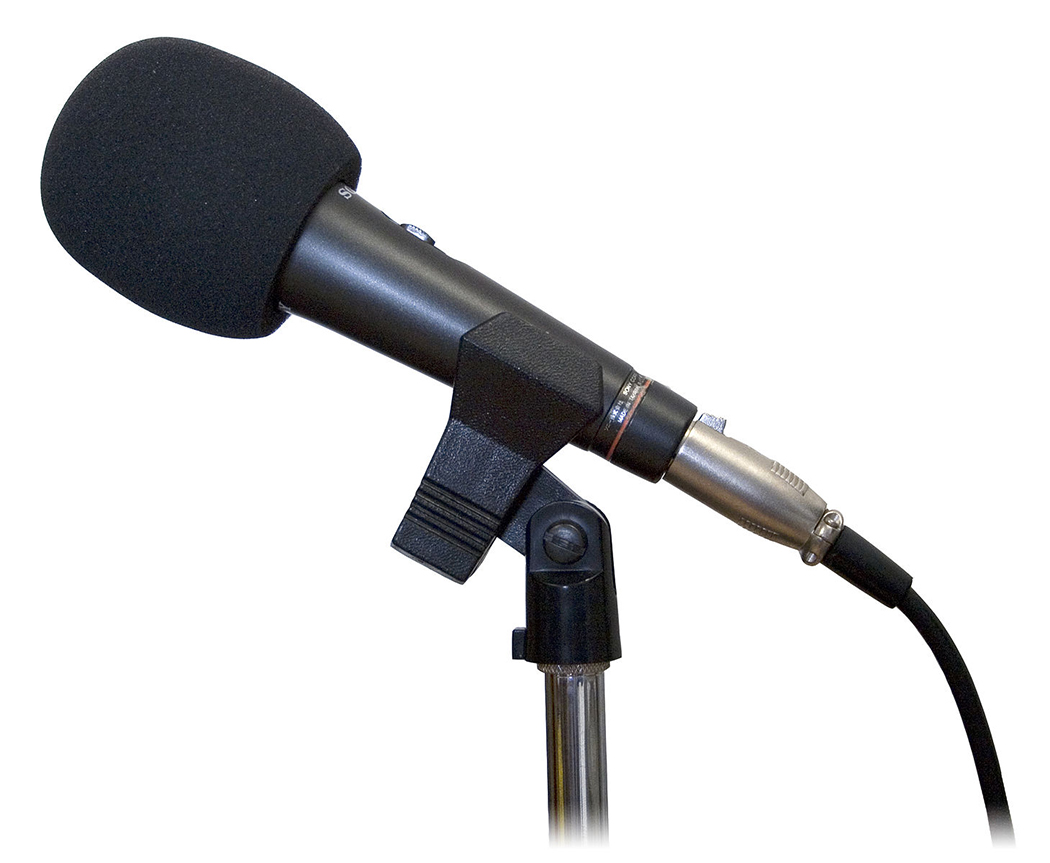 First, radio is broadcasting over the air (and also increasingly, also over the Internet, where it is called streaming or webcasting), while podcasts are recorded files distributed over the Internet through RSS (Really Simple Syndication). Podcasts can be played at the listener’s convenience on any app or device that supports it, of which there are many, including the phones in nearly everyone’s pocket or purse. It is also important to note that podcasting can be done by anyone anywhere (even from one of those phones) and does not require a license or a station, so the number of producers is limitless.
First, radio is broadcasting over the air (and also increasingly, also over the Internet, where it is called streaming or webcasting), while podcasts are recorded files distributed over the Internet through RSS (Really Simple Syndication). Podcasts can be played at the listener’s convenience on any app or device that supports it, of which there are many, including the phones in nearly everyone’s pocket or purse. It is also important to note that podcasting can be done by anyone anywhere (even from one of those phones) and does not require a license or a station, so the number of producers is limitless.
Second, since podcasters from the start have not enjoyed any kind of broad music licensing agreement with producers of recordings, podcasting has been almost all talk. (See, a podcaster needs to “clear rights” for every piece of music played. Live streamers such as Spotify, Apple and Amazon already have their rights cleared broadly through licensing systems.)
This is why podcasting and streaming are body-snatching radio from two sides: podcasting is becoming talk radio, while streaming is becoming music radio.
At the end of this trend, most radio listening will not be on radios, but on phones and other computing devices connected to the Internet. If the trend goes all the way, over-the-air radio will cease. This is already happening to AM radio (called MW outside North America), and may eventually happen to FM as well. Meanwhile, expect talk and music listening on the Internet to continue growing, through streaming and podcasting.
Tags: Industry · Media · Radio
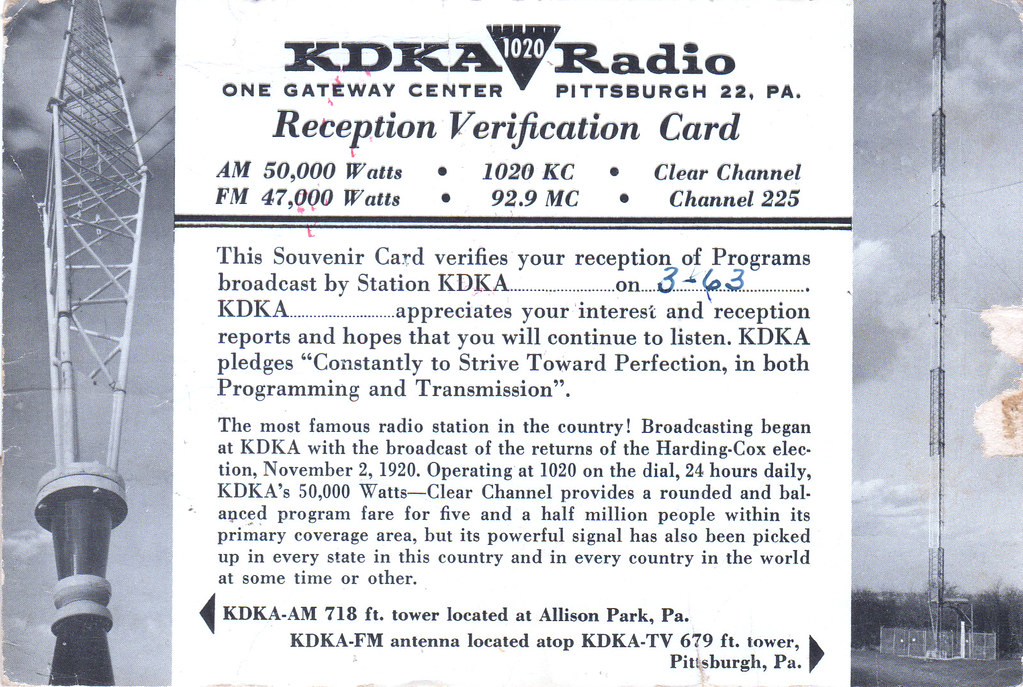
On the I Love AM Radio Facebook group, somebody asked if the branding of legacy AM stations, including giants WFAN/660 in New York and KDKA/1020 in Pittsburgh, would move entirely their FM side (101.9 and 100.1 respectively). I replied,
Eventually, the branding drops for both FM and AM. There will just be legacy callsigns, channels or nicknames, attached to streams on the Net.
As a native New York area sports fan, I enjoy listening to WFAN on 660 AM in the daytime from Cape Cod to Cape May and at night from Maine to the Carolinas—and in Indiana, where I’m living right now. The FM on 101.9 is good for the metro, but gone halfway across New Jersey or out Long Island.
While that may argue for keeping the AM signal alive and branded, another fact is that I can also get the station on my phone, and also in the dashboard of my car. Coverage may only be where there is cellular data; but that’s across most of the developed world. It also sounds better in streamed digital form.
Not that “tuning” into a stream is easy. WFAN has no app of its own. Nor does KDKA, which I’m listening to right now on the live stream on its website, which is a subdomain of the Audacy site. WFAN is similarly subordinated to the same corporate parent.
Both avoid mentioning their AM and FM channels. In the last fifteen minutes, its channels have not been mentioned by KDKA. On WFAN you hear the channels more (or at least 101.9, because they are still somewhat new to that channel and want to promote it).
KDKA’s traffic reporter just said, “on 100.1 FM and AM 1020, KDKA.” I thought that might be the official top-of-the-hour ID, but then the real thing came: a rapidly-spoken recording that said “KDKA AM and HD FM HD2 Pittsburgh. An Audacy station.” Let me unpack that:
• KDKA-AM still exists and may have HD. (Does it?)
• The same stream on FM is itself HD on W261AX/100.1, a 99-watt translator of KDKA-AM, which is also on the HD2 of KDKA-FM on 93.7.
All the big owners—Audacy (Formerly Radio.com, Entercom and CBS Radio), iHeart Radio (formerly Clear Channel), and Cumulus—know that radios have been replaced by phones in pockets and entertainment systems in dashboards and homes. The wireless that matters is digital and cellular, in the sense that home and car wi-fi are now effectively cellular as well. What will survive are branded forms of “content.” Some will be live shows, some will be podcasts, some will be streams of what were once stations and are now apps or streams within apps. AM and FM will eventually be gone. Until then they will survive as legacy expenses, necessary only as long as the FCC continues to require them.
Much as I love AM radio (or I wouldn’t be here), it is a dead band walking. Even for giants like WFAN and KDKA.
Tags: Industry · Media · Radio















 First, radio is broadcasting over the air (and also increasingly, also over the Internet, where it is called streaming or webcasting), while podcasts are recorded files distributed over the Internet through
First, radio is broadcasting over the air (and also increasingly, also over the Internet, where it is called streaming or webcasting), while podcasts are recorded files distributed over the Internet through 